This is the Saint Louis Science Center’s NIGHT SKY UPDATE for the week of Friday, April 9, 2021.
Information updated weekly or as needed.
Times given as local St. Louis time which is Central Daylight Time (CDT). For definitions of terminology used in the night sky update, click the highlighted text. If relying on times posted in Universal Time (UT), St. louis is -5 hours when CDT.
Public Telescope Viewings
Star parties at the Saint Louis Science Center have temporarily been canceled due to recommendations from the CDC regarding COVID-19. All public telescope events are canceled until further notice. As conditions change, we will reevaluate and update this article once public observing events resume.
Observing Highlight of the Week
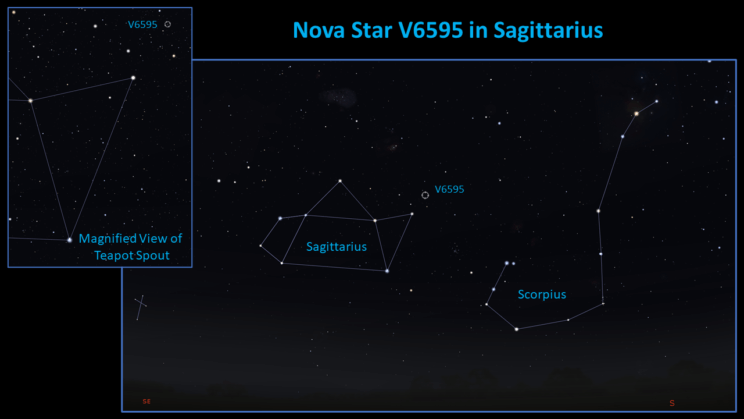
Location of Nova Star V6595 in the Constellation Sagittarius
Credit: Stellarium, EG
Our highlight this week is a star you have a limited time to see. It is called Nova Sagittarius No. 2 or V6595. The reason we have limited time to see V6595 is because it is a classical nova star. Novae are a transient astronomical event that causes the sudden appearance of what seems to be a “new” star. The word nova means new, but novae are far from being a new star. In fact, the stars that cause them are highly evolved stars called white dwarfs. Novae are cataclysmic variable stars that have periodic violent outbursts that are caused by a thermonuclear event at their surface. For a description of different types of cataclysmic variable stars visit the AAVSO.
The scenario that leads to a classical nova is a star like the Sun evolves to its white dwarf stage. Using the Sun as an example, in about 5 billion years the Sun’s core will contract as it evolves from its main sequence to a red giant and then eventually to a white dwarf. For a more detailed description of this process visit NASA’s Imagine the Universe. What makes V6595 different from the future Sun, is it has a companion it closely orbits. As it does this it steals material from its companion star until a critical mass is reached. Once critical there is a runaway thermonuclear event that causes a sudden brightening of the star making it seem like a new star suddenly appeared. This sudden increase in magnitude can last for a few weeks up to a few months.
V6595 was discovered on April 4, 2021 and reached a peak magnitude of 7.7. Current magnitude estimates suggest V6595 has already started to fade. It is currently listed at 8.42. For those that would like to see this nova star, you will need to look for the constellation Sagittarius. You can find this constellation in the south by 3:30 a.m. The key is to first look for Scorpius which has a distinct fishhook shape. Once you can see that, just east of the fishhook, you will find a teapot shape of stars. This is the constellation Sagittarius. Once you see the teapot, look for the spout, which will then point you to the nova star. See to image above.
Dark Sky Week Continues
International Dark Sky Week concludes on April 12. This event was started by Jennifer Barlow in 2003 and has since grow to be an international event. Its intent is to bring awareness to light pollution and its negative effects. Most of us are familiar with light pollution due to the night sky we see from places like St. Louis. Light pollution is more than just a visual concern as we now know it can impact plants and animals which includes humans.
You can join the Dark Sky Week efforts by doing a few things. First, we can turn off any lights that are not necessary. As part of this effort the planetarium building will be dark during Dark Sky Week. In addition to turning off lights, we can all spend a little time learning about light pollution, its negative effects and how we can help mitigate its effects. One of the best sources of information on light pollution is the International Dark-Sky Association. For readers that live in the St. Louis Metro area, there is a local chapter of IDA in Missouri. You can find their website at https://darkskymissouri.org/index.php. Through them, you can learn about reginal efforts being made such as Lights Out Heartland, which are helping bring awareness to the negative effects of light pollution.
Observing the World Around Us
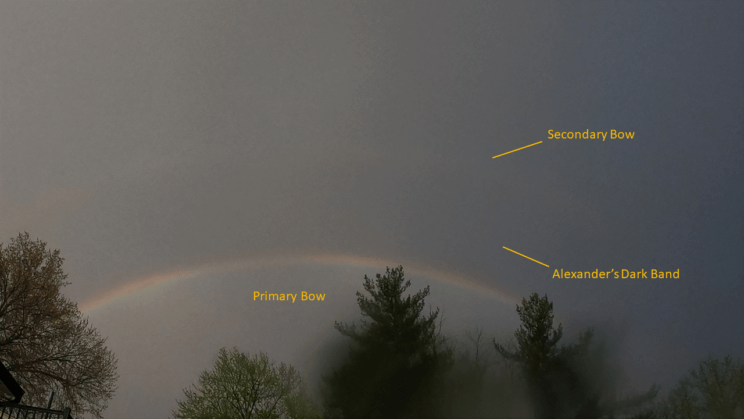
Double Rainbow Seen on April 6, 2021, St. Louis, Missouri
Credit: Eric Gustafson
Periodically, I will add an image of the week highlighting something of interest in the world around us. As we venture outside to explore the wonders of space, there are many other things or phenomena around us worth exploring.
The image above is a rainbow that formed thanks to severe weather that occurred on April 6, 2021. Rainbows are a well-known optical effect that occur as light encounters suspended water droplets in the atmosphere. Traditionally the light source is sunlight. As sunlight encounters a water droplet, it is reflected and refracted in a way that leads to the formation of the colorful display we know so well.
Rainbows take very specific conditions to form. The two most important factors are suspended water droplets are in front of the viewer and a light source must be behind the observer at a proper angle. The physics of how rainbows form is too detailed for this post, so if you are curious about the details, I recommend visiting Les Cowley’s atmospheric optics website. This is one of the best resources for learning about rainbows and other atmospheric optics.
If you look closely at the above image, there are several features you might notice. First it was a double rainbow. Look at the order of colors in the primary and secondary bow. Are they the same? You might also notice that inside the rainbow, things look brighter. Additionally, the space between the primary and secondary bows looks darker. This is called Alexander’s Dark Band. Rainbows are an interesting natural curiosity. They are far less common the most would think and they have several features that one can observe when you take a closer look. A great way to start exploring rainbows is to use a hose with a sprayer that can be set to a misting function. The next time you are out water plants, see if you can get a rainbow to appear. Remember that water droplets need to be in front of you and the light source needs to be behind your viewing direction. Depending on the Sun’s altitude, you may need to change the angle you are spraying water either up or down.
The Sun and Moon

The Moon as seen from the International Space Station, on July 31, 2011.
Credit: NASA
Sunrise is at 6:33 a.m. on Friday, April 9 and sunset is at 7:32 p.m. providing us with over 12.5 hours of daylight. Even after sunset, the light from the Sun will dimly illuminate our sky for about 1 hour and 40 minutes. This period is called twilight, which ends around 9:06 p.m. this week. For those with a sundial, local noon occurs around 13:03 p.m. this week.
| Day | Sunrise | Sunset |
|---|---|---|
| 2021-04-09 | 6:33 a.m. | 7:32 p.m. |
| 2021-04-10 | 6:32 a.m. | 7:33 p.m. |
| 2021-04-11 | 6:30 a.m. | 7:34 p.m. |
| 2021-04-12 | 6:29 a.m. | 7:35 p.m. |
| 2021-04-13 | 6:27 a.m. | 7:36 p.m. |
| 2021-04-14 | 6:26 a.m. | 7:37 p.m. |
| 2021-04-15 | 6:25 a.m. | 7:38 p.m. |
| 2021-04-16 | 6:23 a.m. | 7:39 p.m. |
| 2021-04-17 | 6:22 a.m. | 7:40 p.m. |
Moon
Moonrise for Friday, April 9 occurs at 5:49 a.m. and moonset will occur tomorrow at 5:20 p.m. On Friday, April 9 the Moon will exhibit a waning crescent phase with 5% of the lunar disk visible. New moon occurs on April 11 at 9:31 p.m.
International Space Station (ISS) Observing

There are no visible passes of ISS this week for St. Louis. There are several good passes of another satellite known as X-37B. This is a reusable robotic spacecraft operated by the U.S. Air Force. This week the two best passes of X-37B occur on the mornings of April 13 and 16. Use the table below for more information. ISS will return to St. Louis skies on April 21 as it returns to early morning passes.
Catch X-37B from St. Louis starting Friday, April 9
| Date | Starts | Max. altitude | Ends | |||||||
|---|---|---|---|---|---|---|---|---|---|---|
| Time | Alt. | Az. | Time | Alt. | Az. | Time | Alt. | Az. | ||
| 13 Apr | 0.6 | 06:00:35 | 10 | WSW | 06:03:46 | 84 | SSE | 06:06:56 | 10 | ENE |
| 16 Apr | 0.4 | 04:45:05 | 77 | SW | 04:45:16 | 85 | SSE | 04:48:28 | 10 | ENE |
Magnitude (Mag): The Measure of brightness for a celestial object. The lower the value is, the brighter the object will be.
Altitude (Alt): The angle of a celestial object measured upwards from the observer’s horizon.
Azimuth (Az): The direction of a celestial object, measured clockwise from an observer’s location with north being 0°, east being 90°, south being 180° and west being 270°.
For information about ISS flyovers and other visible satellites, visit www.heavens-above.com
Detailed information regarding all unmanned exploration of our universe, missions past, present, and planned, can be found at Jet Propulsion Laboratories:
The Visible Planets
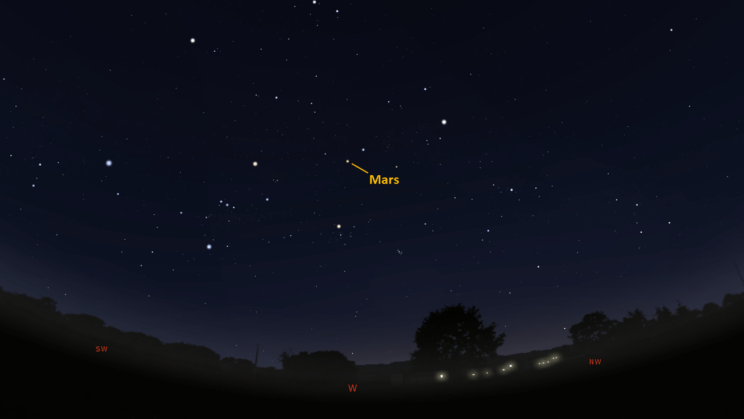
Looking West, at 8:30 pm, April 9, 2021
Credit: Stellarium, EG,
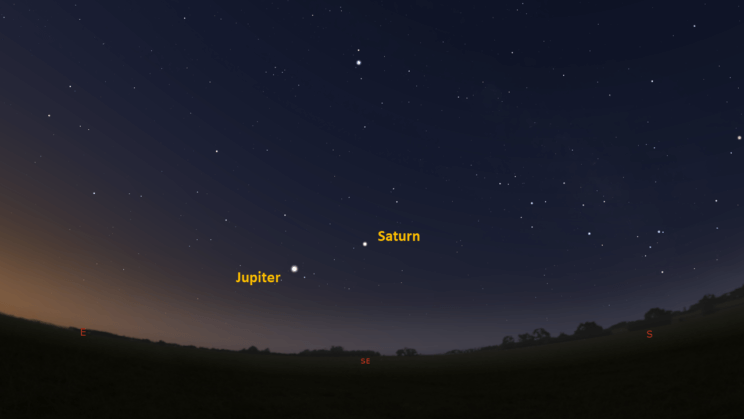
Looking Southeast, at 5:45 am, April 10, 2021
Credit: Stellarium, EG
This week, three naked eye planets are visible. Mars is found high in the west after sunset. Jupiter and Saturn can be found in the southeast before sunrise.
Venus
Venus is starting another evening apparition. It is still a little too close to the Sun to see but Venus should be easy to spot by the start of May shortly after sunset.
Mars
Currently Mars appears as a 1.4-magnitude object that will be visible high in the west about 40 minutes after sunset. Mars sets by 12:37 a.m.
Jupiter
Jupiter is visible in the southeast before sunrise. Jupiter rises at 4:24 a.m. Your best chance to see Jupiter will come about 1-hour before sunrise.
Saturn
Saturn has returned to our morning sky. Saturn rises at 3:46 a.m. and will be easy to spot by 4:45 a.m. looking southeast.
Mars Perseverance Rover Update
After a successful landing on Mars, NASA’s newest rover Perseverance is beginning the early stages of its mission. Each week this section will contain a few of the images sent back to Earth as Perseverance explores Jezero crater. If you have not seen it yet, the first thing I would recommend watching is a video NASA released of the rover’s landing.
The Ingenuity helicopter that landed on Mars with the Perseverance rover is about to take its first flight. This flight is scheduled to occur on April 14, 2021. Learn more about Ingenuity here.
NASA’s Mars Exploration Program website will be a good resource to visit each day to find any updates on the rover and its mission. Aside from information about Perseverance, NASA’s website will keep you up to date on any new findings from other Mars missions and research.
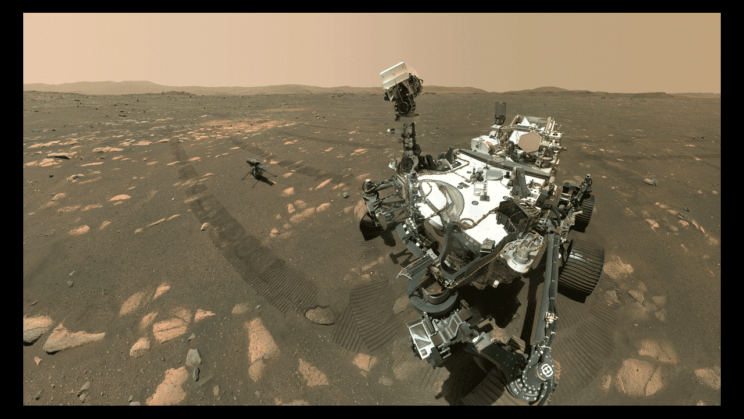
Perseverance and Ingenuity on the Surface of Mars
Credit: NASA/JPL-Caltech/MSSS
James S. McDonnell Planetarium
Night Sky Update: April 09-April 17, 2021






